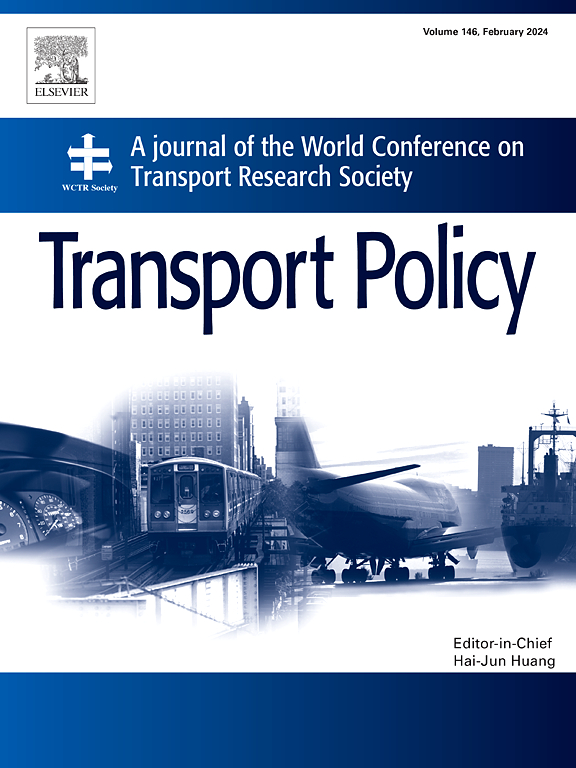Intercity Road Transportation Assessment: Double-Frontier Q-Cross-Efficiency Method
IF 6.3
2区 工程技术
Q1 ECONOMICS
引用次数: 0
Abstract
Road transportation is a crucial component of the overall transportation system, providing public services for both passengers and freight. It is imperative for both government entities and transport operators to continuously assess and enhance the performance of road transportation to effectively meet the needs of passengers and freight stakeholders. This research aims to provide road transportation policymakers with a novel and effective hybrid method that incorporates Q-methodology to address the limitations of the conventional Cross-Efficiency (CE) method, particularly by utilizing both correlated and uncorrelated perspectives. The Q-methodology enables policymakers to identify and exclude Decision-Makers' (DMs') viewpoints, including sets of cross-efficiencies with low correlations, during the analysis process. It employs factor analysis to extract consensus perspectives, thereby providing a more realistic assessment of transportation unit efficiency and reducing the likelihood of biased results. The proposed technique incorporates the Q-methodology into the double-frontier CE method, referred to as DFQCE, to enhance its effectiveness by eliminating uncorrelated viewpoints from the efficiency evaluation process. The conventional CE method utilizes both correlated and uncorrelated viewpoints, which may introduce bias into the results. Furthermore, recent critiques have emerged regarding efficiency evaluations that rely solely on the efficient frontier, as these evaluations do not take into account the assessment results of transportation units from a pessimistic viewpoint, which may differ significantly from those based on the efficient frontier. By incorporating both pessimistic and optimistic perspectives, Double-Frontier Q-based Cross Efficiency (DFQCE) aims to produce more comprehensive outcomes compared to the conventional CE method. To validate the developed methodology, the road transportation operations of thirty-one Iranian provinces are evaluated using four input and three output indicators. Loading factors of 0.7 and 0.6 are selected for the optimistic and pessimistic views, respectively, to encompass the broadest range of cross-efficiencies, accounting for 93% and 96%. To enhance the performance of provinces facing subpar conditions, policy, and theoretical implications are suggested. The findings will be of considerable significance to provincial administrators and national policymakers in road transportation, as they provide insights that can facilitate more effective management of the sector by addressing inefficiencies within the provinces.
城际道路交通评价:双边界q -交叉效率法
公路运输是整个运输系统的重要组成部分,为乘客和货物提供公共服务。政府机构和运输经营者都必须不断评估和提高道路运输的绩效,以有效地满足旅客和货运利益相关者的需求。本研究旨在为道路交通政策制定者提供一种新颖有效的混合方法,该方法结合q -方法论来解决传统交叉效率(CE)方法的局限性,特别是通过利用相关和不相关的视角。q -方法论使决策者能够在分析过程中识别和排除决策者(dm)的观点,包括低相关性的交叉效率集。它采用因素分析来提取共识的观点,从而提供一个更现实的评估运输单位效率和减少有偏见的结果的可能性。该技术将q -方法学整合到双边界CE方法(DFQCE)中,通过消除效率评估过程中不相关的观点来提高其有效性。传统的CE方法使用了相关和不相关的观点,这可能会给结果带来偏差。此外,最近出现了对仅依靠有效边界的效率评价的批评,因为这些评价没有从悲观的角度考虑运输单位的评估结果,这可能与基于有效边界的评估结果有很大不同。通过结合悲观和乐观的观点,双边界Q-based交叉效率(DFQCE)旨在产生比传统CE方法更全面的结果。为了验证所开发的方法,使用四个投入和三个产出指标评估了伊朗31个省的道路运输业务。乐观和悲观观点分别选择0.7和0.6的装载系数,以涵盖最广泛的交叉效率范围,分别占93%和96%。为提高欠发达省份的绩效,本文提出了政策和理论建议。研究结果对省级管理者和国家道路运输政策制定者具有相当重要的意义,因为它们提供了见解,可以通过解决各省的低效率问题,促进更有效地管理该部门。
本文章由计算机程序翻译,如有差异,请以英文原文为准。
求助全文
约1分钟内获得全文
求助全文
来源期刊

Transport Policy
Multiple-
CiteScore
12.10
自引率
10.30%
发文量
282
期刊介绍:
Transport Policy is an international journal aimed at bridging the gap between theory and practice in transport. Its subject areas reflect the concerns of policymakers in government, industry, voluntary organisations and the public at large, providing independent, original and rigorous analysis to understand how policy decisions have been taken, monitor their effects, and suggest how they may be improved. The journal treats the transport sector comprehensively, and in the context of other sectors including energy, housing, industry and planning. All modes are covered: land, sea and air; road and rail; public and private; motorised and non-motorised; passenger and freight.
 求助内容:
求助内容: 应助结果提醒方式:
应助结果提醒方式:


